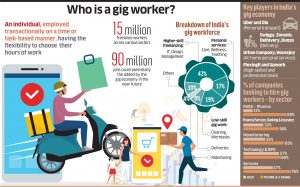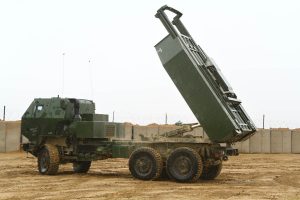Today Current Affairs:3rd June 2022 for UPSC IAS exams, State PSC exams, SSC CGL, State SSC, RRB, Railways, Banking Exam & IBPS, etc
Table of Contents
Why Neptune And Uranus Appear In different Colours?

Astronomers now have an explanation for why Neptune and Uranus appear in different colours.
- Neptune and Uranus have much in common — they have similar masses, sizes, and atmospheric compositions — yet their appearances are in different shades of blue.
- At visible wavelengths, Neptune is a rich, deep azure hue, while Uranus is a distinctly pale shade of cyan.
- The reason is that the haze around Uranus is thicker than that around Neptune.
- Uranus’s stagnant, sluggish atmosphere makes it appear a lighter tone than Neptune.
- If there was no haze in the atmospheres of Neptune and Uranus, both would appear almost equally blue as a result of blue light being scattered in their atmospheres.
Gig Workers:

Concerned at the lack of job and social security among gig and platform workers, the Centre has decided to train officials of the Union and State governments on technological change, new forms of employment, working conditions and mechanisms to protect labour and social security rights of these workers.
- Gig workers are independent contractors, online platform workers, contract firm workers, on-call workers and temporary workers.
- The V.V. Giri Institute, the training arm of the Union Labour Ministry, is organising the programme aimed at sharing information and good experiences on policies and global practices relating to gig and platform workers and their social security.
- Examples such as social security for platform workers in the transport sector of Thailand and Malaysia, where there are online models under which 2% for every ride is deducted for health and accident insurance and for social security will be taken up during the session.
- Another issue that will be taken up is the employer-employee relationship in the context of the gig economy.
- Workers’ employment relationships are not recognised in law in this case and gig workers are largely excluded from labour and social security rights.
- Though there are certain benefits for youth and migrant workers, such as quick money and flexible work hours in the gig platforms, uncertain working hours and insufficient income are still considered major issues that need governmental address
UN Report On The Taliban Regime:

According to the United Nations Security Council (UNSC)’s Analytical Support and Sanctions Monitoring Team, foreign terrorist organisations continue to enjoy safe haven under the new Taliban regime.
- The monitoring team assists the UNSC sanctions committee and its report, circulated among committee members, informs the formulation of UN strategy in Afghanistan.
- India is currently the chair of the sanctions committee, which comprises all the 15 UNSC members.
- This report is the first since the Taliban returned to power in August 2021.
- This is the first of its reports not informed by official Afghan briefings.
- The team collected data by consulting with UN member states, international and regional organisations, private sector financial institutions, and the work of bodies such as the United Nations Assistance Mission in Afghanistan (UNAMA).
- UNAMA is a UN Special Political Mission established to assist the state and the people of Afghanistan in laying the foundations for sustainable peace and development.
What Is The E-transmission Moratorium?

India will oppose the continuation of a moratorium on Customs Duties on electronic transmission (E-Transmission) at the World Trade Organization’s (WTO) 12th Ministerial Conference (MC12) starting in June 2022 as it favors developed nations only
- At the 12th MC in June 2022, many WTO members are seeking temporary extension of the moratorium till 13th MC but India does not want this time to continue this further.
- India and South Africa on several occasions have asked the organization to revisit the issue and have highlighted the adverse impact of the moratorium on developing countries.
- India wants the WTO to intensify the work programme on the e-commerce sector.
- India has also stated that the Council for Trade in Goods, Council for Trade in Services, Council for TRIPS (Trade Related Aspects of Intellectual Property Rights) and the Committee for Trade and Development should take up discussions on e-commerce as per their respective mandates originally set.
- India believed that formal negotiations in the WTO on rules and disciplines in e-commerce would be premature given the highly asymmetrical nature of the existing global e-commerce space and lack of understanding on the implications of the multi-faceted dimensions of issues related to the sector.
- The moratorium was extended at the 11th MC in Argentina in 2017 for two years.
- In the General Council meeting in December 2019, members agreed to maintain the current practice till the 12th MC.
- The WTO members had agreed not to impose customs duties on electronic transmissions since 1998 and the moratorium has been periodically extended at successive Ministerial Conferences (MC), which is the highest decision making body of the 164-member organisation (WTO).
- The moratorium is on digitisable products like photographic films, cinematographic films, printed matter, music, media, software, and video games.
- In 1998, ministers at the Second Ministerial Conference adopted the Declaration on Global Electronic Commerce, calling for the establishment of a work programme on e-commerce, which was adopted later that year.
- Since most countries didn’t have concrete policies on e-commerce, which was an emerging area of trade in even developed countries in 1998, they had decided to establish a work programme on it to hold intensive talks and impose a moratorium on customs duties on electronics transmission.
- In 1998, the General Council of the WTO established the work programme on e-commerce to comprehensively examine all trade-related issues pertaining to global e-commerce by considering the economic, financial and development needs of emerging economies.
- The WTO Work Programme on electronic commerce defines electronic commerce” as the “production, distribution, marketing, sale or delivery of goods and services by electronic means.”
Caste based Census : Bihar

A multi-party meeting held in Bihar unanimously decided to start the caste-based census very soon after the proposal is placed in the Cabinet.
- All parties which have representation in the legislature attended the meeting, chaired by Chief Minister Nitish Kumar.
- It would be a “time-bound exercise and each and every detail of caste, sub-castes, community and religion will be taken care of for the development of all people”.
- Earlier, the Bihar Legislature passed resolutions twice for caste-based census and an 11-member all-party delegation too had met Prime Minister Narendra Modi to demand the exercise.
- However, the Central government had rejected their demand saying it would be a “divisive exercise” but said “States can hold caste census on their own”.
- Once this exercise will be over in Bihar, the other States too may follow suit and the whole nation will be covered”, the Chief Minister, Nitish Kumar, said.
First Liquid Nano Urea (LNU) Plant At Kalol, Gujarat:

The Prime Minister inaugurated the first Liquid Nano Urea (LNU) plant at Kalol, Gujarat.
- It is Indigenous Urea, introduced firstly by the Indian Farmers Fertiliser Cooperative Limited (IFFCO) for farmers across the world.
Liquid Nano Urea:
- It is urea in the form of a nanoparticle.
- It is a nutrient (liquid) to provide nitrogen to plants as an alternative to the conventional urea.
- Urea is a chemical nitrogen fertiliser, white in colour, which artificially provides nitrogen, a major nutrient required by plants.
- It is developed to replace conventional urea and it can curtail the requirement of the same by at least 50%.
- It contains 40,000 mg/L of nitrogen in a 500 ml bottle which is equivalent to the impact of nitrogen nutrient provided by one bag of conventional urea.
- It has been indigenously developed at Nano Biotechnology Research Centre, Kalol, Gujrat in line with Atmanirbhar Bharat and Atmanirbhar Krishi.
- India is dependent on imports to meet its urea requirements.
- It is aimed at reducing the unbalanced and indiscriminate use of conventional urea, increase crop productivity, and reduce soil, water, and air pollution.
Safety Of Aadhaar:

The Unique Identification Development Authority of India (UIDAI) chose to withdraw its advisory two days after it was issued, encouraging users to desist from distributing photocopies of their Aadhaar Card.
- The notification has been withdrawn to avoid any misinterpretation
- UIDAI advisory say Holders should utilise a masked Aadhaar card instead of the traditional photocopy.
- The document must not be downloaded from a cybercafé or a public computer, and if it is, it must be wiped from the system permanently.
- The first eight numbers of the twelve-digit ID are hidden behind ‘XXXX’ characters in ‘Masked Aadhaar.’
Government-e-Marketplace (GeM):

The Union Cabinet cleared a proposal allowing cooperatives to sell products on the Government-e-Marketplace (GeM) platform in a transparent manner.
- The move will benefit 27 crore people associated with 8.5 lakh cooperatives.
- The micro and medium small industries will get buyers and it will boost the prospects of “Vocal for local” and Atma Nirbhar Bharat.
- The cooperatives may, however, be charged a transaction fee to cover the incremental costs.
- The validated list of cooperatives to be onboarded on the GeM — for pilot as well as subsequent scale-up — will be decided by the Ministry of Cooperation in consultation with the GeM SPV [Special Purpose Vehicle].
- The GeM started in 2017 is a one-stop portal to facilitate online procurement of commonly used goods and services.
- The portal is open for all government buyers — Union and State Ministries, departments, public sector enterprises, autonomous institutions, local bodies and so on.
- Private buyers cannot buy on the platform but private people can sell products to government bodies through the portal.
Stockholm+50:

Stockholm+50 is being held in Stockholm, Sweden. It will commemorate the 50 years since the 1972 United Nations (UN) Conference on the Human Environment (also known as the Stockholm Conference).
- The UN General Assembly will be convening this international meeting.
- This is being held at a time when the world is facing a triple planetary crisis of climate change, pollution and waste, nature and biodiversity loss, as well as other planetary issues even after 50 years of the Stockholm Declaration.
- This is threatening the achievement of the Sustainable Development Goals.
- A sustainable recovery from the Covid-19 pandemic will also remain as one of agenda points.
Stockholm Conference, 1972
- Climate change was first discussed using emerging scientific evidence in the UN General Assembly in 1968.
- In 1967, a research study provided the actual estimates of global temperature based on CO2 levels.
- Also, it was predicted that the doubling of CO2 from the current level would result in nearly 2°C rise in global temperature.
- The idea of the Stockholm Conference was first proposed by Sweden. That’s why it’s also termed the “Swedish Initiative”.
- The United Nations Conference on the Human Environment in Stockholm was held from 5th –16th June, 1972.
- This was the first global convergence on the planetary environment.
- The theme was ‘Only One Earth’.
- 122 countries participated in the conference.
- Aim:
- Creating a common governance framework for the planetary environment and natural resources.
- Stockholm Declaration and Action Plan for the Human Environment
Stockholm Declaration:
- 70 out of 122 participant countries which were developing and poor countries adopted the Stockholm Declaration.
- The Stockholm Declaration contained 26 principles that marked the beginning of a dialogue between developed and developing countries.
- This built the “interconnections between development, poverty and the environment”.
- The Action Plan contained three main categories that were further broken down into 109 recommendations:
- Global Environmental Assessment Programme (watch plan)
- Environmental management activities
- International measures to support assessment and management activities carried out at the national and international levels.
HIMAR Systems:

United States would send four HIMAR systems to Ukraine
- The M142 HIMARS, a light multiple rocket launcher, was developed for the US Army in the late 1990s.
- The High Mobility Artillery Rocket System (HIMARS) is mounted on a truck, and can carry a container with six rockets.
- The HIMARS can launch a medium-range rocket, but is also capable of firing a longer-range missile, the Army Tactical Missile System, which has a range of about 300 km.




